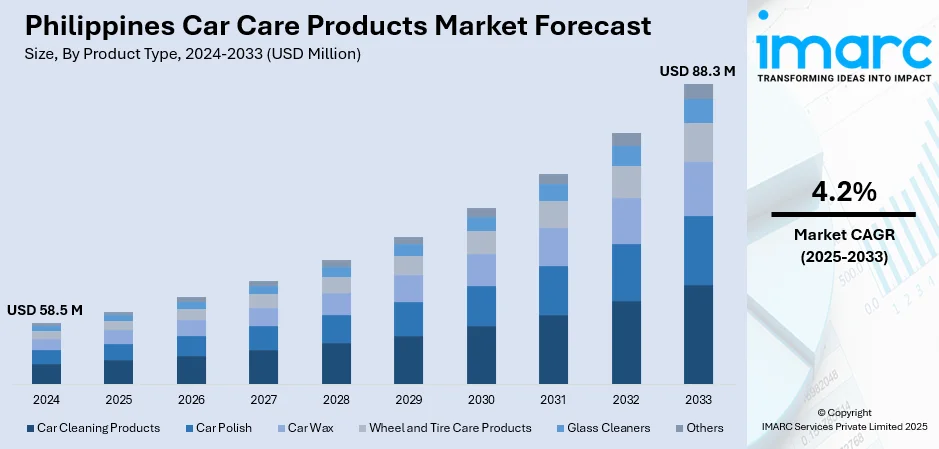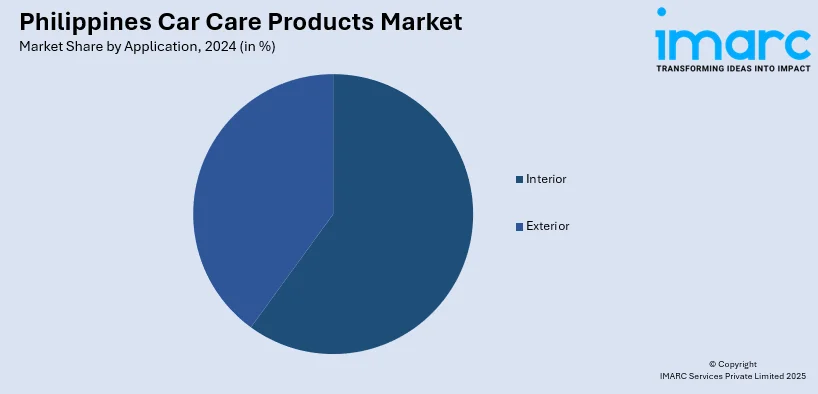
Philippines Car Care Products Market Report by Product Type (Car Cleaning Products, Car Polish, Car Wax, Wheel and Tire Care Products, Glass Cleaners, and Others), Application (Interior, Exterior), Distribution Channel (DIY/Retail Stores, DIFM/Service Centers), and Region 2025-2033
Philippines Car Care Products Market Overview:
The Philippines car care products market size reached USD 58.5 Million in 2024. Looking forward, IMARC Group expects the market to reach USD 88.3 Million by 2033, exhibiting a growth rate (CAGR) of 4.2% during 2025-2033. The market is propelled by the increasing disposable income levels of individuals, rising car ownership rates, increasing influence of social media and digital marketing, rising urbanization, increasing traffic congestion, robust growth in the tourism and transportation industry.
|
Report Attribute
|
Key Statistics
|
|---|---|
|
Base Year
|
2024
|
|
Forecast Years
|
2025-2033
|
|
Historical Years
|
2019-2024
|
|
Market Size in 2024
|
USD 58.5 Million |
|
Market Forecast in 2033
|
USD 88.3 Million |
| Market Growth Rate 2025-2033 | 4.2% |
Philippines Car Care Products Market Trends:
Increasing Disposable Income Level of Individuals
The market for car care products in Philippines performs considerably well on account of the higher levels of disposable income among the residents of the region, which in turn, results in an increased spending on car care products. Besides, the rising middle-class population is seeking better aesthetics in their vehicle appearance thereby creating a positive market outlook. About half (50.1%) of the population across the Philippine region, is middle-income, based on the PHILIPPINE STATISTICS AUTHORITY (PSA). This demographic change is further exacerbated by the rapid urbanization. The increasing migration toward the urban region in search of better opportunities, are increasingly depending on personal vehicles as compared to shared mass transportation. Furthermore, in the Philippines there is a high cultural significance attached to automobiles, thereby resulting in individuals spending more and more on the maintenance and appearance of their vehicles, creating the demand for a variety of car care products and services.

To get more information on this market, Request Sample
Increasing Car Ownership Rates
The steady growth of the Philippine economy has facilitated an increase in household income and also created greater access to credit and financing options, making car ownership more achievable for a wider segment of the population. This easy accessibility to vehicle ownership has led to a significant surge in the number of cars on the roads of the region, displaying a shift toward a more motorized society. As more cars function the streets, individuals are becoming more aware of the necessity of proper maintenance so as to safeguard the value and longevity of their vehicles. Beyond mere transportation, cars have become substantial investments for numerous families, encouraging them to prioritize upkeep and care. This growing consciousness associated with vehicle maintenance has propelled an increase in the demand for car care products, ranging from basic cleaning supplies to customized detailing tools.
Influence of Social Media and Digital Marketing
The proliferation of social media platforms and online marketplaces has revolutionized how consumers discover and purchase products, including car care items. Influencers and bloggers often showcase their car detailing routines and recommend various products, influencing consumer preferences and driving sales. Moreover, digital marketing strategies such as targeted advertisements and promotions have widened the reach of car care product manufacturers, further fueling market growth. Moreover, digital marketing strategies such as targeted advertisements and promotions have further amplified the reach of car care product manufacturers. Through platforms like Facebook, Instagram, and Google Ads, brands can precisely target their ads to users based on demographics, interests, and online behavior, ensuring that their message reaches the right audience at the right time. Overall, the influence of social media and digital marketing has transformed the way consumers discover, research, and purchase car care products in the Philippines. As these platforms continue to evolve and play an increasingly central role in consumer behavior, car care product manufacturers must adapt their marketing strategies to effectively engage with their target audience and capitalize on the opportunities presented by the digital landscape.
Philippines Car Care Products Market News:
- May 8, 2024: SONAX PHILIPPINES introduced its novel range of premium car care products. These DIY products, named as the SONAX XTREME PPF SERIES, SONAX XTREME CERAMIC SERIES, and SONAX BEAT TIRE and WHEEL CLEANER will be available at their official LAZMALL and AHOPPE MALL stores, or at premium auto shops such as BLADE.
Philippines Car Care Products Market Segmentation:
IMARC Group provides an analysis of the key trends in each segment of the market, along with forecasts at the country level for 2025-2033. Our report has categorized the market based on product type, application, and distribution channel.
Product Type Insights:
- Car Cleaning Products
- Car Polish
- Car Wax
- Wheel and Tire Care Products
- Glass Cleaners
- Others
The report has provided a detailed breakup and analysis of the market based on the product type. This includes car cleaning products, car polish, car wax, wheel and tire care products, glass cleaners, and others.
Application Insights:

- Interior
- Exterior
The report has provided a detailed breakup and analysis of the market based on the application. This includes interior and exterior.
Distribution Channel Insights:
- DIY/Retail Stores
- DIFM/Service Centers
The report has provided a detailed breakup and analysis of the market based on the distribution channel. This includes DIY/retail stores and DIFM/service centers.
Regional Insights:
- Luzon
- Visayas
- Mindanao
The report has also provided a comprehensive analysis of all the major regional markets, which include Luzon, Visayas, and Mindanao.
Competitive Landscape:
The market research report has also provided a comprehensive analysis of the competitive landscape. Competitive analysis such as market structure, key player positioning, top winning strategies, competitive dashboard, and company evaluation quadrant has been covered in the report. Also, detailed profiles of all major companies have been provided.
Philippines Car Care Products Market Report Coverage:
| Report Features | Details |
|---|---|
| Base Year of the Analysis | 2024 |
| Historical Period | 2019-2024 |
| Forecast Period | 2025-2033 |
| Units | Million USD |
| Scope of the Report | Exploration of Historical and Forecast Trends, Industry Catalysts and Challenges, Segment-Wise Historical and Predictive Market Assessment:
|
| Product Types Covered | Car Cleaning Products, Car Polish, Car Wax, Wheel and Tire Care Products, Glass Cleaners, Others |
| Applications Covered | Interior, Exterior |
| Distribution Channels Covered | DIY/Retail Stores, DIFM/Service Centers |
| Regions Covered | Luzon, Visayas, Mindanao |
| Customization Scope | 10% Free Customization |
| Post-Sale Analyst Support | 10-12 Weeks |
| Delivery Format | PDF and Excel through Email (We can also provide the editable version of the report in PPT/Word format on special request) |
Key Questions Answered in This Report:
- How has the Philippines car care products market performed so far and how will it perform in the coming years?
- What is the breakup of the Philippines car care products market on the basis of product type?
- What is the breakup of the Philippines car care products market on the basis of application?
- What is the breakup of the Philippines car care products market on the basis of distribution channel?
- What are the various stages in the value chain of the Philippines car care products market?
- What are the key driving factors and challenges in the Philippines car care products?
- What is the structure of the Philippines car care products market and who are the key players?
- What is the degree of competition in the Philippines car care products market?
Key Benefits for Stakeholders:
- IMARC’s industry report offers a comprehensive quantitative analysis of various market segments, historical and current market trends, market forecasts, and dynamics of the Philippines car care products market from 2019-2033.
- The research report provides the latest information on the market drivers, challenges, and opportunities in the Philippines car care products market.
- Porter's five forces analysis assist stakeholders in assessing the impact of new entrants, competitive rivalry, supplier power, buyer power, and the threat of substitution. It helps stakeholders to analyze the level of competition within the Philippines car care products industry and its attractiveness.
- Competitive landscape allows stakeholders to understand their competitive environment and provides an insight into the current positions of key players in the market.
Need more help?
- Speak to our experienced analysts for insights on the current market scenarios.
- Include additional segments and countries to customize the report as per your requirement.
- Gain an unparalleled competitive advantage in your domain by understanding how to utilize the report and positively impacting your operations and revenue.
- For further assistance, please connect with our analysts.
 Request Customization
Request Customization
 Speak to an Analyst
Speak to an Analyst
 Request Brochure
Request Brochure
 Inquire Before Buying
Inquire Before Buying




.webp)




.webp)












